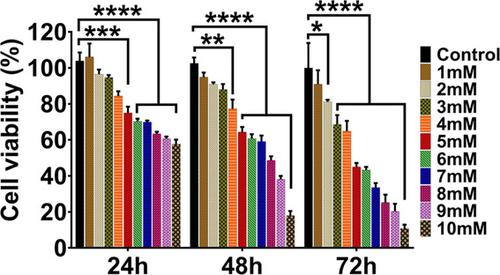当前位置:
X-MOL 学术
›
Ann. N. Y. Acad. Sci.
›
论文详情
Our official English website, www.x-mol.net, welcomes your
feedback! (Note: you will need to create a separate account there.)
Characterization of hydrogen sulfide toxicity to human corneal stromal fibroblasts
Annals of the New York Academy of Sciences ( IF 4.1 ) Pub Date : 2020-09-20 , DOI: 10.1111/nyas.14498 Praveen K Balne 1, 2 , Nishant R Sinha 1, 2 , Alexandria C Hofmann 2 , Lynn M Martin 1, 2 , Rajiv R Mohan 1, 2, 3
Annals of the New York Academy of Sciences ( IF 4.1 ) Pub Date : 2020-09-20 , DOI: 10.1111/nyas.14498 Praveen K Balne 1, 2 , Nishant R Sinha 1, 2 , Alexandria C Hofmann 2 , Lynn M Martin 1, 2 , Rajiv R Mohan 1, 2, 3
Affiliation

|
Hydrogen sulfide gas (H2S) is a chemical weapon and a common environmental pollutant. H2S intoxication is lethal to humans and animals. H2S contact to the eye can cause vision loss. However, the molecular mechanisms associated with H2S toxicity to the cornea remain unclear, and no specific therapy exists to mitigate ocular damage from H2S. Here, we report H2S‐induced cytotoxicity and the parameters contributing to the molecular mechanisms associated with corneal toxicity using primary human corneal stromal fibroblasts (hCSFs) in vitro. Sodium hydrosulfide (NaSH) was used as a source of H2S, and the cytotoxicity of H2S was determined by treating hCSF cells with varying concentrations of NaSH (0–10 mM) for 0–72 hours. Changes in cell proliferation, oxidative stress factors, and the expression of inflammatory and fibrotic genes were studied using standard commercial kits and qRT‐PCR. NaSH exposure to hCSFs showed dose‐ and time‐dependent cytotoxicity. The IC50 of NaSH was determined to be 5.35 mM. NaSH 5.35 mM exposure led to significantly decreased cytochrome c oxidase activity, increased ROS production, and increased expression of inflammatory and fibrotic genes in hCSF cells. H2S/NaSH exposure alters normal mitochondrial function, oxidative stress, and inflammatory and fibrotic gene responses in corneal stromal fibroblasts in vitro.
中文翻译:

硫化氢对人角膜基质成纤维细胞毒性的表征
硫化氢气体(H2S)是一种化学武器,也是一种常见的环境污染物。硫化氢中毒对人类和动物来说是致命的。 H2S 接触眼睛会导致视力丧失。然而,与 H2S 对角膜毒性相关的分子机制仍不清楚,并且没有特定的治疗方法可以减轻 H2S 对眼部的损伤。在这里,我们在体外使用原代人角膜基质成纤维细胞(hCSF)报告了 H2S 诱导的细胞毒性以及与角膜毒性相关的分子机制的参数。使用硫氢化钠 (NaSH) 作为 H2S 来源,通过用不同浓度的 NaSH (0–10 mM) 处理 hCSF 细胞 0–72 小时来测定 H2S 的细胞毒性。使用标准商业试剂盒和 qRT-PCR 研究细胞增殖、氧化应激因子以及炎症和纤维化基因表达的变化。 NaSH 暴露于 hCSF 表现出剂量和时间依赖性细胞毒性。 NaSH 的 IC50 测定为 5.35 mM。 NaSH 5.35 mM 暴露导致 hCSF 细胞中细胞色素 c 氧化酶活性显着降低、ROS 产生增加以及炎症和纤维化基因表达增加。 H2S/NaSH 暴露会改变体外角膜基质成纤维细胞的正常线粒体功能、氧化应激以及炎症和纤维化基因反应。
更新日期:2020-09-20
中文翻译:

硫化氢对人角膜基质成纤维细胞毒性的表征
硫化氢气体(H2S)是一种化学武器,也是一种常见的环境污染物。硫化氢中毒对人类和动物来说是致命的。 H2S 接触眼睛会导致视力丧失。然而,与 H2S 对角膜毒性相关的分子机制仍不清楚,并且没有特定的治疗方法可以减轻 H2S 对眼部的损伤。在这里,我们在体外使用原代人角膜基质成纤维细胞(hCSF)报告了 H2S 诱导的细胞毒性以及与角膜毒性相关的分子机制的参数。使用硫氢化钠 (NaSH) 作为 H2S 来源,通过用不同浓度的 NaSH (0–10 mM) 处理 hCSF 细胞 0–72 小时来测定 H2S 的细胞毒性。使用标准商业试剂盒和 qRT-PCR 研究细胞增殖、氧化应激因子以及炎症和纤维化基因表达的变化。 NaSH 暴露于 hCSF 表现出剂量和时间依赖性细胞毒性。 NaSH 的 IC50 测定为 5.35 mM。 NaSH 5.35 mM 暴露导致 hCSF 细胞中细胞色素 c 氧化酶活性显着降低、ROS 产生增加以及炎症和纤维化基因表达增加。 H2S/NaSH 暴露会改变体外角膜基质成纤维细胞的正常线粒体功能、氧化应激以及炎症和纤维化基因反应。











































 京公网安备 11010802027423号
京公网安备 11010802027423号